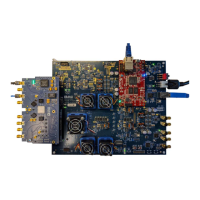UG-1829 EVAL-AD9081/EVAL-AD9082/EVAL-AD9986/EVAL-AD9988 User Guide
Rev. 0 | Page 12 of 26
HMC7044
AD9081/AD9082/AD9986/AD9988
CRYSTAL
OSCILLATOR
EXT_HMCREF
PLL1
CLKIN0/
RFSYNCIN
CPOUT1 OSCIN
VOLTAGE CONTROLLED
CRYSTAL OSCILLATOR
SCLKOUT3
CLKOUT0, CLKOUT6, CLKOUT8
CLKOUT10, CLKOUT12, SCLKOUT13
TO FPGA VIA FMC CONNECTOR
CLKIN1/
FIN
PLL2
OUTPUT
DISTRIBUTION
DIVIDER
SYNC
BLOCK
PLL
CLKOUT2
CLKINP/
CLKINN
SYSREFP/
SYSREFN
C4D/C6D
C3D/C5D
C2C/C4C
C1C/C3C
EXT_CLK
EXT_SYS_P/
EXT_SYS_N
ADC
DAC
24165-015
Figure 20. Default Clocking Scheme Used for the AD9081, AD9082, AD9986, or AD9988 Evaluation Board
SET UP THE INSTRUMENTATION
To use on-board clocking, the user must only provide an analog
input signal using a signal generator. To analyze DAC outputs, a
spectrum analyzer is needed.
The following are recommended instruments and connectors:
Signal generator: a low phase noise signal generator, such
as the Rohde & Schwarz SMA (100A or 100B) or
Keysight UXG/EXG series. Note that the performance
listed in the product data sheet is from the Rohde &
Schwarz SMA100B with the B-711 option.
Spectrum analyzer: Keysight PXA/UXA or Rohde &
Schwarz FSW/FSWP.
Cables: use a shielded, RG-58, 50 Ω coaxial cable.
Ensure that the 10 MHz references are shared between the
instruments.
Analog Devices recommends the coaxial, 48.0 in. (1.2 m or
4.0 ft), RG316 DS, SMA to SMA, male to male cable assembly
from Cinch Connectivity Solutions Johnson, Part Number 415-
0033-048 for the setup.
Set Up the Spectrum Analyzer
Analog Devices recommends the following configuration for
the spectrum analyzer:
Start frequency = 50 MHz (or 0 MHz)
Stop frequency = 5 GHz
Resolution bandwidth = 30 kHz
Use an average or rms detector setting and set the input
attenuation to 6 dB or as desired
These settings can be changed to satisfy the particular use case.
It is recommended to have all the instruments share a common
reference. Usually, this common reference is achieved by
connecting the 10 MHz reference output from one instrument
to the reference input of the next, and so on.

